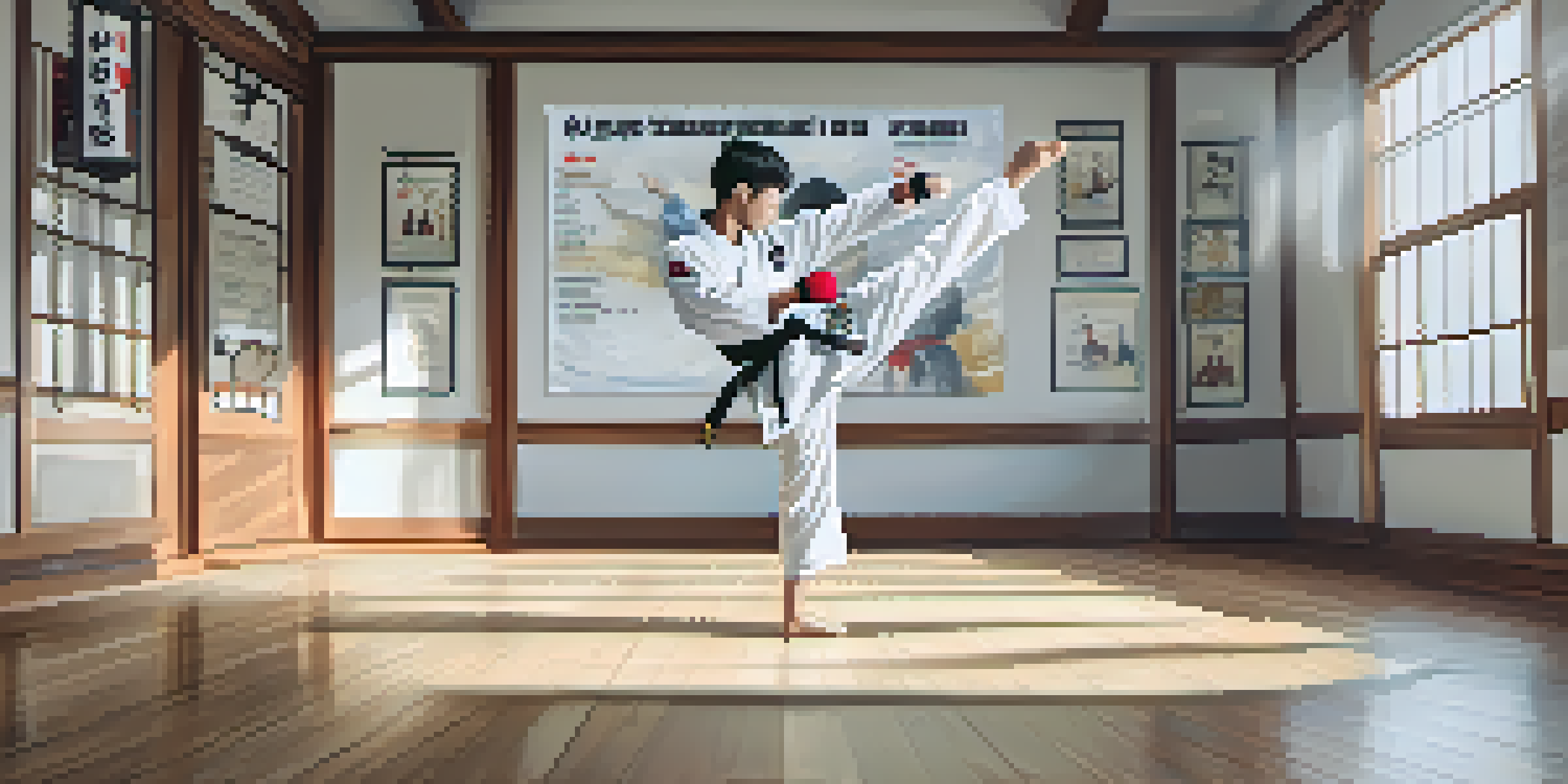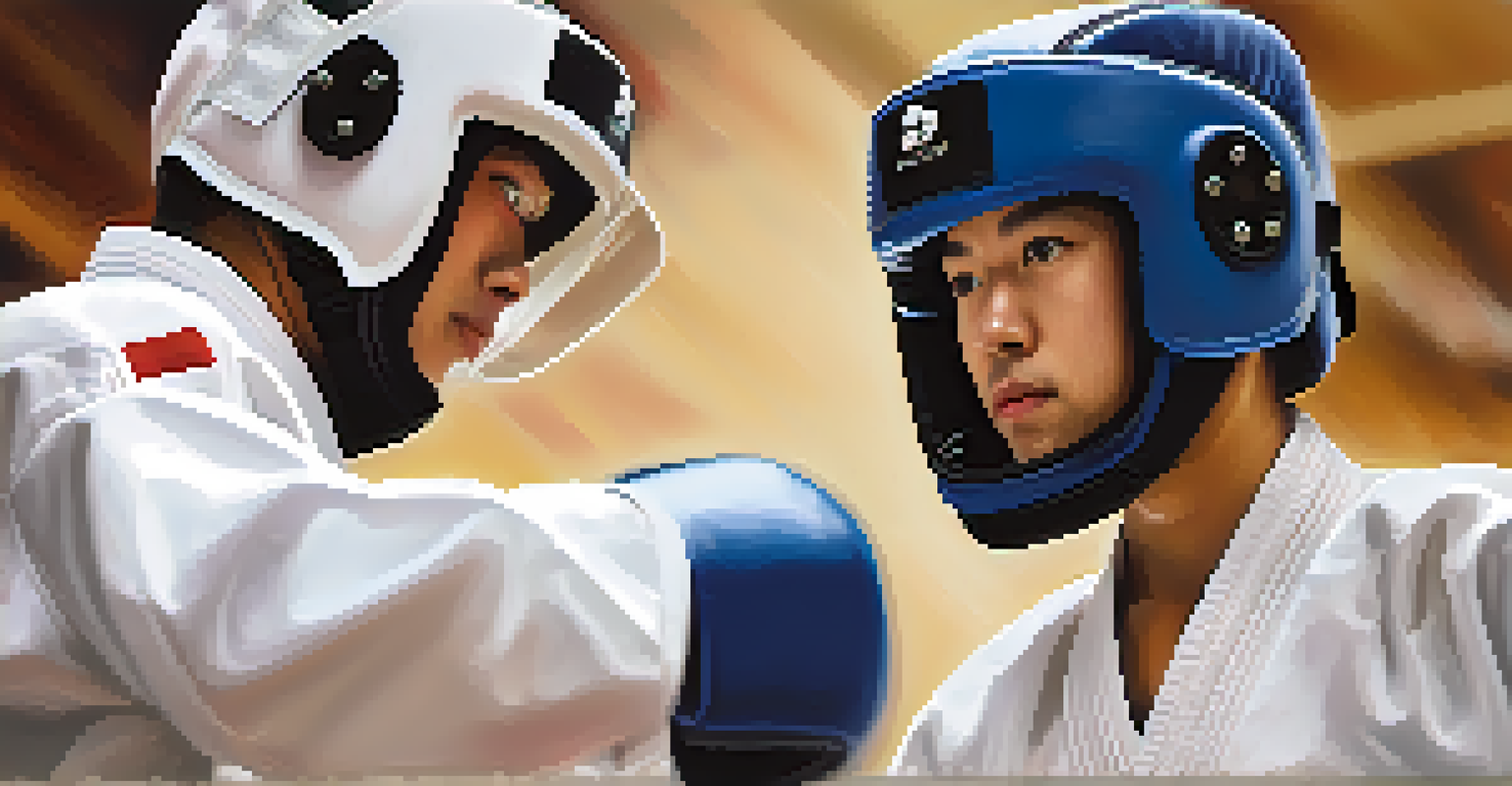Using Taekwondo Principles to Resolve Everyday Conflicts

Understanding Taekwondo Principles for Conflict Resolution
At its core, Taekwondo is about discipline, respect, and balance. These principles can be incredibly useful when navigating everyday conflicts. Just like in martial arts, where one must assess their surroundings and opponents, we can analyze the dynamics of our interactions with others.
The greatest victory is that which requires no battle.
Conflict often arises from misunderstandings or differing perspectives. By applying Taekwondo principles, we encourage a mindset that values respect for all parties involved, paving the way for more constructive dialogues. This approach fosters an environment where resolution becomes the focus, rather than winning the argument.
Moreover, the discipline learned in Taekwondo instills patience, allowing us to think before reacting. This pause can be crucial, as it helps prevent knee-jerk responses that may escalate conflicts further. In essence, the principles of Taekwondo prepare us mentally and emotionally for conflict resolution.
The Importance of Respect in Conflict Situations
Respect is a foundational element of Taekwondo that can transform conflict resolution. In the heat of disagreement, remembering to treat the other person with respect creates a safer space for dialogue. This doesn’t mean you have to agree; rather, it means acknowledging the other person's viewpoint.

For example, when a colleague disagrees with your idea in a meeting, responding with respect can shift the tone of the discussion. Instead of becoming defensive, consider their perspective and ask questions to understand their reasoning. This respectful approach can often lead to collaborative solutions that satisfy both parties.
Respect Shapes Conflict Resolution
Maintaining respect during disagreements fosters a safer dialogue and encourages collaborative solutions.
Additionally, practicing respect can mitigate feelings of hostility. When people feel valued, they are more likely to listen and engage constructively. This principle aligns perfectly with the Taekwondo philosophy of building a supportive community, rather than fostering competition.
Balance: Finding Common Ground in Disagreements
In Taekwondo, balance is essential not just physically but also mentally. When conflicts arise, finding balance can mean identifying common ground with the other party. This involves recognizing shared goals or values, which can pave the way for resolution.
In the middle of difficulty lies opportunity.
For instance, if two friends have differing opinions about where to eat, rather than arguing, they can each suggest options that they like. This process of compromise reflects the balance practiced in martial arts, where both parties contribute to a solution. It shows that conflict doesn’t have to be combative; it can be collaborative.
Moreover, achieving balance requires active listening. By genuinely hearing the other person’s concerns, you can better navigate the discussion and steer it towards mutual understanding. This Taekwondo-inspired approach encourages harmony, rather than discord.
Flexibility: Adapting Your Approach in Conflicts
Flexibility, much like in Taekwondo techniques, plays a crucial role in resolving conflicts. Sometimes, sticking rigidly to your stance can hinder progress. Instead, adopting a flexible mindset allows for adjustments based on the situation at hand.
For example, if a family member is upset about a holiday plan, instead of insisting on your original idea, you might explore alternatives that satisfy everyone. This adaptability can defuse tension and foster a cooperative spirit, much like how a Taekwondo practitioner adjusts their moves to counter an opponent’s attack.
Patience Leads to Better Outcomes
Exercising patience in conflict situations allows for thoughtful reflection and understanding of underlying issues.
Being flexible doesn’t mean compromising your values; it’s about being willing to shift your approach to achieve a positive outcome. This principle empowers you to navigate conflicts with grace, leading to resolutions that benefit all involved.
Learning to Control Emotions During Conflicts
Emotional control is a vital aspect of Taekwondo training, directly applicable to conflict resolution. In moments of disagreement, emotions can run high, clouding our judgment. Therefore, learning to manage these feelings is essential for constructive dialogue.
Practicing techniques from Taekwondo, such as deep breathing or visualization, can help you stay calm when tensions rise. For instance, before responding to a heated email, take a moment to breathe and collect your thoughts. This pause can often prevent impulsive reactions that might escalate the conflict.
Furthermore, controlling your emotions can influence the dynamics of the interaction. When you remain calm, it encourages the other person to do the same, fostering a more productive conversation. This emotional intelligence mirrors the self-regulation taught in Taekwondo, showcasing its relevance beyond the dojo.
The Role of Patience in Conflict Resolution
Patience is a critical virtue in Taekwondo, and it’s equally important in resolving conflicts. Often, we seek immediate solutions, but rushing can lead to misunderstandings or unsatisfactory outcomes. By exercising patience, we allow time for reflection and understanding.
Imagine you’re in a disagreement with a neighbor over property boundaries. Instead of confronting them immediately, taking a step back to gather your thoughts can lead to a more thoughtful approach. This patience can transform a potentially heated confrontation into a calm discussion about shared concerns.
Flexibility Enhances Resolution Skills
Adapting your approach and being willing to compromise can defuse tensions and lead to positive outcomes in conflicts.
Moreover, patience enables us to appreciate the nuances of the situation. Each conflict has its layers, and allowing time for these to unfold can reveal paths to resolution that we might have initially overlooked. This principle teaches us that sometimes, waiting can yield the best outcomes.
Applying Taekwondo Techniques to Real-Life Conflicts
Applying Taekwondo techniques to resolve conflicts can feel unconventional, but the principles are universal. Techniques like footwork and blocking can translate metaphorically to navigating conversations and setting boundaries. These tactics encourage a proactive rather than reactive approach.
For example, if a friend is constantly interrupting you, consider it akin to a block in Taekwondo. You can gently address the issue by saying, 'I appreciate your enthusiasm, but I’d like to finish my thought.' This kind of assertiveness reflects the self-assuredness cultivated in martial arts.

Ultimately, bringing these techniques into everyday life allows for more respectful interactions. Just as Taekwondo practitioners train consistently, applying these principles requires practice. However, over time, they can significantly enhance your ability to resolve conflicts effectively.
Embracing the Journey of Conflict Resolution
Embracing the journey of conflict resolution is akin to the ongoing practice in Taekwondo. Each encounter presents an opportunity to refine your skills and learn from the experience. Like martial arts, conflict resolution is not always about immediate success but about continual growth.
As you apply Taekwondo principles in real life, you’ll likely encounter challenges. However, viewing these moments as learning experiences can help you develop a deeper understanding of yourself and others. This perspective fosters resilience, allowing you to approach future conflicts with renewed confidence.
Ultimately, the blend of Taekwondo principles and conflict resolution empowers you to create healthier relationships. By committing to this journey, you honor the values of respect, patience, and balance that are at the heart of both Taekwondo and meaningful interactions.